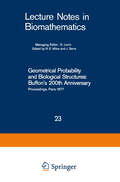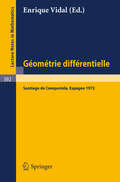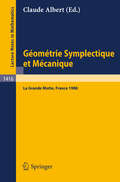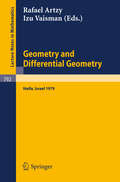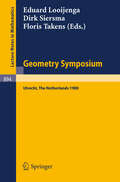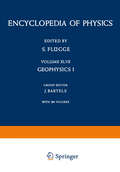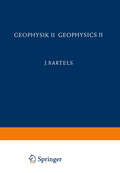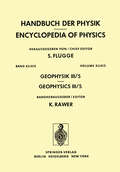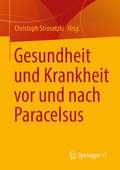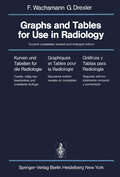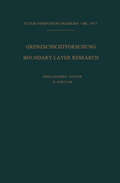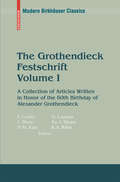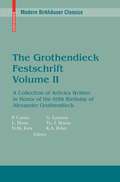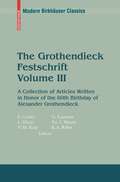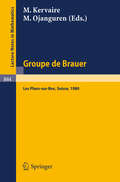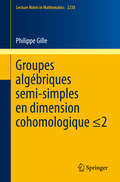- Table View
- List View
Geometric Methods in the Algebraic Theory of Quadratic Forms: Summer School, Lens, 2000 (Lecture Notes in Mathematics #1835)
by Oleg T. Izhboldin Bruno Kahn Nikita A. Karpenko Alexander VishikThe geometric approach to the algebraic theory of quadratic forms is the study of projective quadrics over arbitrary fields. Function fields of quadrics have been central to the proofs of fundamental results since the 1960's. Recently, more refined geometric tools have been brought to bear on this topic, such as Chow groups and motives, and have produced remarkable advances on a number of outstanding problems. Several aspects of these new methods are addressed in this volume, which includes an introduction to motives of quadrics by A. Vishik, with various applications, notably to the splitting patterns of quadratic forms, papers by O. Izhboldin and N. Karpenko on Chow groups of quadrics and their stable birational equivalence, with application to the construction of fields with u-invariant 9, and a contribution in French by B. Kahn which lays out a general framework for the computation of the unramified cohomology groups of quadrics and other cellular varieties.
Geometrical Probability and Biological Structures: Proceedings of the Buffon Bicentenary Symposium on Geometrical Probability, Image Analysis, Mathematical Stereology, and Their Relevance to the Determination of Biological Structures, Held in Paris, June 1977 (Lecture Notes in Biomathematics #23)
by R. E. Miles J. SerraGeometrie algebrique reelle et formes quadratiques: Journees S.M.F., Universite de Rennes 1, Mai 1981 (Lecture Notes in Mathematics #959)
by J. L. Colliot-Thelene M. Coste L. Mahe M. F. RoyGeometrie Differentielle: Colloque, Santiago de Compostela, Espagne (Lecture Notes in Mathematics #392)
by E. VidalGeometrie et theorie des groupes: Les groupes hyperboliques de Gromov (Lecture Notes in Mathematics #1441)
by Michel Coornaert Thomas Delzant Athanase PapadopoulosThe book is an introduction of Gromov's theory of hyperbolic spaces and hyperbolic groups. It contains complete proofs of some basic theorems which are due to Gromov, and emphasizes some important developments on isoperimetric inequalities, automatic groups, and the metric structure on the boundary of a hyperbolic space.
Geometrie Symplectique et Mecanique: Colloque International, La Grande Motte, France, 23-28 Mai, 1988 (Lecture Notes in Mathematics #1416)
by Claude AlbertGeometry and Differential Geometry: Proceedings of a Conference Held at the University of Haifa, Israel, March 18-23, 1979 (Lecture Notes in Mathematics #792)
by R. Artzy I. VaismanGeometry and Topology: Proceedings of the School Held at the Instituto de Matematica Pura e Aplicada CNPq, Rio de Janeiro, July 1976 (Lecture Notes in Mathematics #597)
by Jacob Palis Manfredo DoCarmoIII. Latin American School of Mathematics
Geometry of Homogeneous Bounded Domains: Lectures given at a Summer School of the Centro Internazionale Matematico Estivo (C.I.M.E.) held in Urbino (Pesaro), Italy, July 3-13, 1967 (C.I.M.E. Summer Schools #45)
by E. VesentiniS.G. Gindikin, I.I. Pjateckii-Sapiro, E.B. Vinberg: Homogeneous Kähler manifolds.- S.G. Greenfield: Extendibility properties of real submanifolds of Cn.- W. Kaup: Holomorphische Abbildungen in Hyperbolische Räume.- A. Koranyi: Holomorphic and harmonic functions on bounded symmetric domains.- J.L. Koszul: Formes harmoniques vectorielles sur les espaces localement symétriques.- S. Murakami: Plongements holomorphes de domaines symétriques.- E.M. Stein: The analogues of Fatous’s theorem and estimates for maximal functions.
Geometry Seminar "Luigi Bianchi": Lectures Given at the Scuola Normale Superiore, 1982 (Lecture Notes in Mathematics #1022)
by G. Gentili S. Salamon J.-P. VigueGeometry Symposium Utrecht 1980: Proceedings of a Symposium Held at the University of Utrecht, The Netherlands, August 27-29, 1980 (Lecture Notes in Mathematics #894)
by E. Looijenga D. Siersma F. TakensGeophysik II / Geophysics II (Handbuch der Physik Encyclopedia of Physics #10 / 48)
by Julius Bartels45 downwards because (j on the average increases with height; but this conclusion does not follow from (18.3) when the dependency of Kc upon ~o is taken into consideration. s 2 ERTELl and PRIESTLEY and SWINBANK have shown that the upward eddy flux of sensible heat must be larger than indicated by (18.3), because this formula does not account for the fact that rising eddies are systematically warmer than sinking eddies because of the effect of buoyancy. The reader is referred to the reviews by SUTTON [22], [23] and PRIESTLEY and SHEP PARD [15) for further details concerning eddy-flux of heat and turbulent diffusion. 19. RICHARDSON'S criterion. The right-hand side of (15.10) represents the rate of production of eddy energy. The last term represents energy loss by dissipation; in order that the eddy energy shall be maintained, it is therefore necessary that P div V" - (! V" v" . grad. v > O.
Geophysik III / Geophysics III: Teil V / Part V (Handbuch der Physik Encyclopedia of Physics #10 / 49 / 5)
by Ja. L. Al'pert T. K. Breus K. I. Gringauz W. L. Jones A. T. Vassy E. Vassy W. L. WebbGesundheit und Krankheit vor und nach Paracelsus
by Christoph StrosetzkiBedeutend ist Theophrast von Hohenheim (ca. 1493/4–1541), genannt Paracelsus, vor allem durch sein Aufbegehren gegen die klassischen antiken und arabisch-mittelalterlichen Autoritäten in der Medizin. Grundlage sollen nicht mehr die überlieferten Schriften, sondern experientia, experimenta und ratio sein. Von dieser Basis soll künftig ausgegangen werden, was Paracelsus auch dadurch unterstreicht, dass er seine Schriften in deutscher Sprache veröffentlicht. Indem er sich gegen die dogmatische Auslegung antiker Texte wandte, wollte er die Ära Galens beenden. Die Chirurgie wollte er auf universitären Rang erheben. Nach Paracelsus ist es die Natur, die heilt, wobei der Arzt nur Helfer ist. Wenn er Gesundheit als harmonische Ordnung im organischen Ablauf definiert, dann ist er bestrebt, Makrokosmos und Mikrokosmos, Diesseits und Jenseits, in Einklang zu bringen. Die Welt ist für ihn kein Nebeneinander isolierter Elemente, sondern eine Einheit. Auch beim Menschen erscheint ihm Sinnliches und Seelisches aufeinander bezogen. Archeus nennt er ein immaterielles Prinzip, in dem er den Träger der belebenden Kraft in der Natur und im Menschen, also im Makrokosmos wie im Mikrokosmos, festmacht. Im Sinne der Renaissance sieht er den Menschen als Mittelpunkt des Kosmos und seine Aufgabe im Erkennen der Welt.
Graphs and Tables for Use in Radiology / Kurven und Tabellen für die Radiologie / Graphiques et Tables pour la Radiologie / Gráficas y Tablas para Radiología: Kurven und Tabellen für die Radiologie / Graphiques et tables pour la Radiologie / Graficas y Tablas para Radiologia
by F. Wachsmann G. DrexlerGrenzschichtforschung / Boundary Layer Research: Symposium Freiburg/Br. 26.Bis 29. August 1957 / Symposium Freiburg/Br. August 26–29, 1957 (IUTAM Symposia)
by Heinrich GörtlerGrossissements de filtrations: Seminaire de Calcul Stochastique 1982/83 Universite Paris VI (Lecture Notes in Mathematics #1118)
by Thierry Jeulin Marc YorThe Grothendieck Festschrift, Volume I: A Collection of Articles Written in Honor of the 60th Birthday of Alexander Grothendieck (Modern Birkhäuser Classics Ser.)
by Pierre Cartier Luc Illusie Nicholas M. Katz Gérard Laumon Yuri I. Manin Kenneth A. RibetThis three-volume work contains articles collected on the occasion of Alexander Grothendieck’s sixtieth birthday and originally published in 1990. The articles were offered as a tribute to one of the world’s greatest living mathematicians. Many of the groundbreaking contributions in these volumes contain material that is now considered foundational to the subject. Topics addressed by these top-notch contributors match the breadth of Grothendieck’s own interests, including: functional analysis, algebraic geometry, algebraic topology, number theory, representation theory, K-theory, category theory, and homological algebra.
The Grothendieck Festschrift, Volume II: A Collection of Articles Written in Honor of the 60th Birthday of Alexander Grothendieck (Modern Birkhäuser Classics Ser.)
by Nicholas M. Katz Yuri I. Manin A. Grothendieck P. Cartier Luc Illusie Gérard Laumon Kenneth A. RibetThis three-volume work contains articles collected on the occasion of Alexander Grothendieck’s sixtieth birthday and originally published in 1990. The articles were offered as a tribute to one of the world’s greatest living mathematicians. Many of the groundbreaking contributions in these volumes contain material that is now considered foundational to the subject. Topics addressed by these top-notch contributors match the breadth of Grothendieck’s own interests, including: functional analysis, algebraic geometry, algebraic topology, number theory, representation theory, K-theory, category theory, and homological algebra.
The Grothendieck Festschrift, Volume III: A Collection of Articles Written in Honor of the 60th Birthday of Alexander Grothendieck (Modern Birkhäuser Classics Ser. #88)
by A. Grothendieck P. Cartier L. Illusie N. M. Katz G. Laumon Yu. I. Manin K. A. RibetThis three-volume work contains articles collected on the occasion of Alexander Grothendieck’s sixtieth birthday and originally published in 1990. The articles were offered as a tribute to one of the world’s greatest living mathematicians. Many of the groundbreaking contributions in these volumes contain material that is now considered foundational to the subject. Topics addressed by these top-notch contributors match the breadth of Grothendieck’s own interests, including: functional analysis, algebraic geometry, algebraic topology, number theory, representation theory, K-theory, category theory, and homological algebra.
Groupe de Brauer: Seminaire, Les Plans-sur-Bex, Suisse, 1980 (Lecture Notes in Mathematics #844)
by M. Kervaire M. OjangurenGroupes algébriques semi-simples en dimension cohomologique ≤2: Semisimple algebraic groups in cohomological dimension ≤2 (Lecture Notes in Mathematics #2238)
by Philippe GilleLa théorie des groupes algébriques sur un corps arbitraire est l’une des branches les plus merveilleuses des mathématiques modernes. Cette monographie porte sur les groupes algébriques semi-simples définis sur un corps k de dimension cohomologique séparable ≤2 et la cohomologie galoisienne d’iceux. La question ouverte la plus importante est la conjecture II de Serre (1962) qui prédit l’annulation de la cohomologie galoisienne d’un groupe semi-simple simplement connexe.Utilisant principalement des techniques de groupes algébriques, on couvre tous les cas connus de la conjecture: les cas classiques (dus à Bayer-Fluckiger and Parimala) ainsi que les avancées sur les cas exceptionnels restants (par exemple de type E8). Ceci s’applique à la classification des groupes semi-simples. The theory of algebraic groups over arbitrary fields is one of the most beautiful branches of modern mathematics. This monograph deals with semisimple algebraic groups over a general field k of separable cohomological dimension ^ to Bayer-Fluckiger and Parimala), and some perspectives are given on the remaining exceptional cases (e.g., G of type E8). Applications to the classification of semisimple k-groups are presented.

